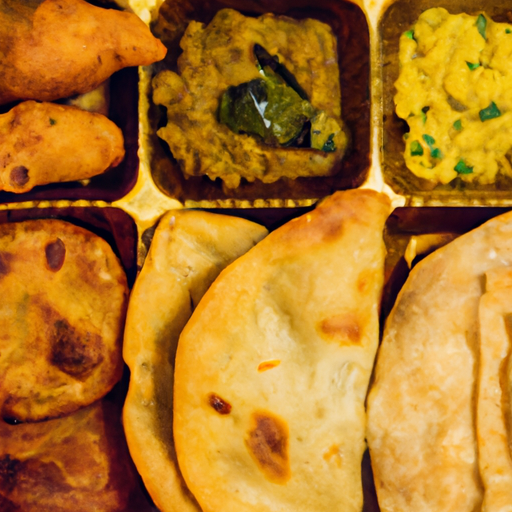Experience the rich and diverse flavors of Indian cuisine with “Authentic Indian Cooking: Traditional Recipes And Methods”. IndianCulture.com invites you to explore the aromatic spices and regional specialties that define the culinary traditions of India. Discover the secrets behind authentic Indian recipes and learn the traditional cooking methods that have been passed down through generations. From mouth-watering curries to delectable desserts, this article will transport you to the vibrant and flavorful world of Indian cooking. Get ready to tantalize your taste buds and embark on a culinary journey through India’s rich cultural heritage.

History of Indian Cuisine
Introduction
Welcome to the world of Indian cuisine! In this article, we will take you on a journey through the rich history and diverse flavors of one of the oldest and most renowned culinary traditions in the world. Indian cuisine is a tapestry of flavors, spices, and traditions that have been shaped by centuries of cultural exchange and regional influences. From ancient origins to modern innovations, Indian food has captivated the palates of people around the globe. So, let’s delve into the fascinating history of Indian cuisine and discover the key ingredients, traditional cooking methods, regional variations, must-try recipes, and more!
Ancient Origins
Indian cuisine has its roots in the ancient civilizations that flourished in the Indus Valley and Ganges plains thousands of years ago. The Indus Valley Civilization, which dates back to around 2500 BCE, left behind evidence of early wheat and barley cultivation, indicating the beginning of agriculture in the Indian subcontinent. This agricultural foundation laid the groundwork for the development of a diverse range of ingredients and culinary techniques.
Influence of Different Cultures
Over the centuries, Indian cuisine has been shaped by a myriad of cultural influences. The Aryans, Persians, Greeks, Mughals, and British, among others, have all left their culinary footprints on Indian soil. The spice trade routes also played a pivotal role in introducing a wide variety of exotic spices to the Indian kitchen, further enriching the flavors of Indian dishes. The blending of foreign culinary practices with indigenous ingredients gave rise to the distinct regional cuisines that exist in India today.
Key Ingredients in Indian Cooking
Spices
Spices are the heart and soul of Indian cuisine. They are used in various forms – whole, ground, roasted, and mixed – to add depth, aroma, and flavor to dishes. Some of the iconic spices used in Indian cooking include cumin, coriander, turmeric, mustard seeds, fenugreek, cardamom, cinnamon, cloves, and black pepper. Each spice has its unique role, whether it’s providing warmth, enhancing the natural sweetness of ingredients, or adding a vibrant color to the dish.
Herbs
Herbs are an integral part of Indian cooking and are used both for flavor and medicinal purposes. Fresh herbs like cilantro (coriander), mint, curry leaves, and fenugreek leaves are extensively used in various dishes. They impart a fresh and aromatic quality to the cuisine, enhancing the overall taste and aroma.
Vegetables
Indian cuisine showcases a wide variety of vegetables, both in traditional and modern recipes. From the humble potato and cauliflower to more exotic veggies like okra, bottle gourd, and bitter gourd, Indian cooking celebrates the diverse range of flavors and textures that vegetables offer. Whether in curries, stir-fries, or side dishes, vegetables play a crucial role in providing nutrition and adding vibrancy to the plate.
Legumes
Legumes, also known as pulses, are a staple in Indian cuisine. Lentils, chickpeas, kidney beans, black-eyed peas, and mung beans are just a few examples of the legumes commonly used. They are packed with protein and essential nutrients, making them a vital component of vegetarian and vegan diets. Legumes are often incorporated in curries, dals (lentil soups), and savory snacks.
Grains
India is a land of diverse grains, each with its unique flavor and nutritional profile. Rice, wheat, millet, sorghum, and corn are some of the key grains used in Indian cooking. Whether it’s fluffy basmati rice, aromatic biryani, or soft and pillowy bread like naan and roti, grains form the backbone of many Indian dishes. The extensive use of grains in various forms makes Indian cuisine a versatile and satisfying culinary experience.

Traditional Indian Cooking Methods
Tandoori
Tandoori cooking is an ancient method that involves cooking food in a clay oven called a tandoor. The intense heat in the tandoor creates a unique smoky flavor and gives the food a charred exterior while keeping it juicy and tender on the inside. Tandoori cooking is often associated with dishes like tandoori chicken, naan bread, and kebabs.
Charring
Charring is another popular cooking method in Indian cuisine. Whether it’s roasting eggplant directly over an open flame or charring spices in a pan, this technique imparts a deep and smoky flavor to the ingredients. Charring is commonly used in dishes like baingan bharta (charred eggplant mash) and tandoori roti.
Tempering
Tempering, also known as tadka or baghaar, involves heating oil or ghee and adding spices to infuse their flavors into the dish. This technique is often used to enhance the taste of dals, curries, and rice dishes. The tempering process releases the aromatic oils and creates a flavorful base for the dish.
Steaming
Steaming is a healthy and gentle cooking method widely used in Indian cuisine. From idlis (steamed rice cakes) to dhoklas (steamed lentil cakes), steaming preserves the natural flavors and textures of the ingredients while minimizing the use of oil. Steaming is commonly employed in South Indian and Gujarati cuisines.
Slow Cooking
Slow cooking is a hallmark of Indian cuisine, allowing flavors to meld together beautifully. Curries, biryanis, and meat stews are often simmered for hours on low heat to develop complex flavors and tenderize the ingredients. This method results in rich and succulent dishes that are deeply satisfying.
Regional Indian Cuisines
North Indian Cuisine
North Indian cuisine is known for its rich, creamy curries, aromatic rice dishes, and indulgent desserts. Influenced by Mughal and Persian culinary traditions, the region boasts iconic dishes like butter chicken and biryani. The use of dairy products, such as ghee and yogurt, is prominent in North Indian cooking, adding richness and depth to the flavors.
South Indian Cuisine
South Indian cuisine showcases a vibrant array of flavors and ingredients. Rice plays a central role, and dishes like dosas, idlis, and sambars are popular staples. Coconut, tamarind, and curry leaves are frequently used to add a tangy and aromatic touch to the dishes. South Indian cuisine is also known for its extensive use of vegetarian and vegan options.
East Indian Cuisine
East Indian cuisine reflects the cultural influences of Bengal, Odisha, and the Northeastern states. Rice, fish, mustard oil, and a wide variety of vegetables feature prominently in East Indian cooking. The cuisine is known for its delicate flavors, subtle spicing, and preference for mustard-based sauces. Iconic dishes like shorshe ilish (hilsa fish in mustard sauce) and rosogolla (sweet cottage cheese balls) originated in this region.
West Indian Cuisine
West Indian cuisine is a tantalizing blend of flavors from Gujarat, Maharashtra, Rajasthan, and Goa. The cuisine embodies a balance of sweet, savory, and tangy flavors. From dhoklas and theplas of Gujarat to spicy vindaloos of Goa, West Indian cuisine showcases a diverse range of dishes. Coconut, peanuts, and spices like cumin and coriander are common ingredients used in this region.

Must-Try Traditional Indian Recipes
Butter Chicken
Butter chicken, also known as murgh makhani, is a classic North Indian dish that has won the hearts of people worldwide. Succulent pieces of chicken are marinated in a spiced yogurt mixture, cooked in a tandoor or oven, and then simmered in a creamy tomato and butter sauce. The rich flavors and velvety texture of butter chicken make it a must-try dish for anyone venturing into Indian cuisine.
Biryani
Biryani is a fragrant rice dish that showcases the culinary expertise of Indian cooks. Basmati rice is cooked with aromatic spices, meat (such as chicken, lamb, or fish), and sometimes vegetables, all layered together to create a flavorful and vibrant one-pot meal. Biryani is a celebration of flavors and textures that vary from region to region, making it a cornerstone of Indian cuisine.
Masala Dosa
Masala dosa is a popular South Indian breakfast dish that has gained popularity worldwide. It is a thin, crispy rice and lentil crepe filled with a spicy potato-based filling. Served with coconut chutney and sambar (a lentil-based vegetable stew), masala dosa is a delightful and satisfying meal that combines the flavors of tangy, spicy, and savory.
Rajma Chawal
Rajma chawal is a comforting and hearty dish enjoyed in North Indian households. It consists of kidney beans cooked in a rich and flavorful tomato-based gravy, served with steamed rice. The combination of creamy beans and fragrant rice creates a balanced and wholesome meal that showcases the essence of Indian home-cooking.
Gulab Jamun
Gulab jamun is a beloved Indian dessert that satisfies the sweet tooth of millions. These soft and syrup-soaked dumplings are made by combining dough made from milk solids and a touch of flour, rolled into small balls, and then deep-fried until golden brown. The fried dumplings are then immersed in a fragrant sugar syrup flavored with rose water and cardamom. Indulgent and delicious, gulab jamun is the perfect finale to any Indian meal.
Vegan and Vegetarian Options
Importance of Vegetarianism in Indian Cuisine
Vegetarianism holds a significant place in Indian cuisine due to cultural, religious, and ethical reasons. Many Indians follow vegetarian or vegan diets for spiritual beliefs, such as Jainism and certain sects of Hinduism. This tradition has given rise to a multitude of delectable and satisfying vegetarian and vegan dishes that demonstrate how flavorful and diverse plant-based cooking can be.
Popular Vegan Indian Dishes
Indian cuisine offers a plethora of vegan options that are both nutritious and packed with flavors. Dishes like chana masala (spiced chickpea curry), baingan bharta (charred eggplant mash), dal makhani (creamy lentil curry), and aloo gobi (potato and cauliflower curry) are just a few examples of vegan delicacies that have become favorites worldwide. These dishes showcase the versatility and creativity of Indian cooking when it comes to plant-based meals.
Indian Street Food
Introduction to Street Food Culture in India
Indian street food is a vibrant and integral part of Indian food culture. Streets across India come alive with stalls and carts selling a dizzying array of snacks and delicacies. Street food provides a unique culinary experience, allowing you to immerse yourself in the bustling atmosphere and indulge in a variety of flavors and textures that represent the diversity of Indian cuisine.
Popular Street Food Snacks
From crispy and tangy pani puri (hollow fried dough filled with flavored water) to savory and spicy pav bhaji (buttery bread rolls with a spicy vegetable curry), Indian street food offers an endless list of delectable snacks. Other popular street food items include vada pav (potato fritter sandwich), samosas (deep-fried savory pastries), and momos (steamed dumplings). Exploring Indian street food is like embarking on a delightful gastronomic adventure that promises to awaken your taste buds.
Celebratory and Festive Indian Dishes
Role of Food in Indian Celebrations
Food plays a significant role in Indian celebrations and festivals. It has the power to bring families and communities together, symbolizing joy, abundance, and togetherness. Whether it’s Diwali (Festival of Lights), Eid, Christmas, or weddings, Indian celebrations are incomplete without a spread of traditional dishes that reflect the regional customs and culinary traditions.
Traditional Dishes for Festivals
Each festival in India has its own set of traditional dishes that are prepared with love and care. For example, during Diwali, the festival of lights, families indulge in a variety of sweets, such as jalebi (deep-fried spiral-shaped sweets) and barfi (milk-based fudge). On Eid, biryani and sheer khurma (a sweet vermicelli pudding) take center stage. Christmas brings treats like plum cake and rose cookies. These festive dishes are a testament to the diversity and richness of Indian cuisine.
Spices and Flavor Combinations
Common Spices Used in Indian Cooking
Indian cuisine is renowned for its vibrant and aromatic spices, which create the foundation for its distinct flavors. Some common spices used in Indian cooking include cumin, coriander, turmeric, mustard seeds, fenugreek, cardamom, cinnamon, cloves, and black pepper. The skillful use of these spices in various combinations and ratios gives Indian dishes their unique and complex flavor profiles.
Balancing Flavors in Indian Dishes
Indian cuisine is a masterclass in flavor balance, combining sweet, sour, salty, and spicy elements in harmonious proportions. The delicate balance of flavors is achieved through the careful blend of spices, herbs, souring agents (such as tamarind or lemon juice), and sweetness from ingredients like jaggery or coconut. Each dish seeks to strike a perfect balance, making every bite a symphony of flavors.
Tips for Mastering Authentic Indian Cooking
Understanding Flavor Profiles
To master authentic Indian cooking, it’s essential to understand the flavor profiles of different regional cuisines. Each cuisine has its unique combination of spices and herbs, resulting in a specific taste and aroma. Experimenting with regional recipes and understanding the balance of flavors will help you create authentic and delicious Indian dishes.
Proper Use of Spices
Spices are the backbone of Indian cuisine, and using them correctly is crucial for bringing out their true flavors. Some spices are best used whole, while others are more effective when ground. Learning how to use spices at different stages of cooking and in the right proportions will enhance the taste and aroma of your dishes.
Control of Heat and Timing
Indian cooking often involves layering flavors and building complexity over time. Managing heat levels and cooking times carefully is key to achieving the desired texture and flavor. Whether it’s slow-cooking a curry or tempering spices for a tadka, understanding heat control and timing will take your Indian cooking to the next level.
Embark on a Culinary Adventure
With its rich history, diverse regional variations, and mouth-watering recipes, Indian cuisine offers a culinary adventure like no other. From the humble masala dosa to the opulent butter chicken, every dish tells a story and invites you to savor the depth of flavors that Indian cooking has to offer. So, put on your apron, gather your spices, and let the aroma of traditional Indian dishes transport you to the vibrant and diverse culinary world of India. Happy cooking!
